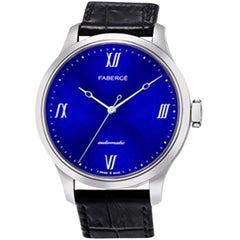Faberge Altruist
Recent Sales
2010s British Wrist Watches
White Gold
2010s British Wrist Watches
White Gold
2010s British Wrist Watches
Rose Gold
Fabergé for sale on 1stDibs
While the House of Fabergé is best known for creating the lavishly ornate and intricately devised Imperial Easter eggs given by the last czars to their families as annual holiday gifts, it was the most prestigious Russian luxury goods maker of the late 19th and early 20th centuries.
Serving the aristocracy and the well-to-do through stores in St. Petersburg, Moscow and as far afield as London, Fabergé crafted a wide range of brooches and other jewelry, clock cases, silver and myriad objets de vertu that included picture frames, cigarette cases, cufflinks and carved hardstone floral and animal figurines. Following the revolution, the firm was closed by the Soviet state in 1918.
Master goldsmith Gustav Fabergé, a descendant of Huguenot emigrées, founded the company in St. Petersburg in 1842. The firm did a brisk trade among the lesser nobility and the merchant class, but it flourished under the guidance of Gustav’s eldest son Peter Carl Fabergé — known also as Karl Gustavovich Fabergé — who took over in 1872.
Cosmopolitan, widely-traveled and himself a master goldsmith — he was sent on a Grand Tour in the 1860s — the younger Fabergé drew early design inspiration when he volunteered to catalogue and restore pieces in the imperial jewelry collection in the Hermitage.
Fabergé pieces based on historical jewelry from the Hermitage caught the attention of Czar Alexander III at a Moscow exhibition in 1882, and three years later he commissioned the first Imperial Easter egg as a gift for the czarina. Czar Nicholas II continued the tradition, presenting two eggs each Easter — one for his wife and one for his mother.
Relatively simple in design compared to the complex cloisonné-adorned eggs that followed, the first Fabergé egg was a white-enameled ovoid containing a gold “yolk” that held a gold hen, which in turn contained a replica of the imperial crown from which hung an egg-shaped ruby pendant.
As the appointed goldsmith to the royal court, the House of Fabergé became the darling of Russian aristocrats as well as wealthy patrons across Europe. Many and varied objets — hundreds of thousands by one count — were made to meet their demand. The firm employed some 500 craftsmen and designers when it was shuttered.
After the Russian Revolution, the Fabergé name and trademark endured a checkered passage through the 20th century.
Family members left their homeland in 1918 and set up a new business in Paris that was mainly concerned with repairing and restoring earlier-made wares. The name was adopted by an American fragrance and beauty products maker in the late 1930s, and later authorized by the family in a 1951 agreement. The trademark has been subsequently sold several times, and attached to numerous products including jewelry.
Fabergé pieces are richly redolent of a romantic past, and a source of thorough delight — for connoisseurs, true Fabergé refers to items made in the firm’s brief, golden decades from 1885 to 1917.
Collectors are advised to make a study of Fabergé works in museum collections such as the Victoria & Albert and the Royal Collection in London to gain an understanding of the quality of genuine goods made by the original firm, and then to purchase only from reputable and reliable dealers, such those at 1stDibs.
Find Fabergé eggs for sale and other objects and vintage jewelry on 1stDibs.
Finding the Right wrist-watches for You
Antique, new and vintage wristwatches have captured the hearts and minds of all manner of watch collectors as well as the watchmakers themselves — it's time you found your own.
Certain vintage watches for men and iconic watch designs for women are sought after not only because of their graceful proportions or innovative materials but also because of the illustrious histories of the houses that created them, histories that they stylishly embody.
Bulgari’s legendary Serpenti watch was on everyone’s list after the collection’s bold bracelet, which technically debuted after the timepiece, graced the wrist of actress Elizabeth Taylor. If anything, elaborately crafted timepieces — the unmistakably boxy silhouette of Cartier Tank watches, the elegant and minimal Calatrava designed by legendary Swiss house Patek Philippe — are even more effective than the shape we associate with traditional wristwatches.
Form watches — the all-encompassing moniker bestowed upon non-round watches — are making headlines and completing contemporary fashionable ensembles the world over. At the same time, both casual fans and careful collectors are drawn to the unbeatable charm of vintage styles, such as the icons designed by Omega that even James Bond can’t resist.
In the early days of watchmaking, watches were fragile enough that they necessitated protection from the elements. Now, wristwatches made of gold and steel can withstand the harshest climates — even 100 meters underwater, in the case of Rolex’s Submariner. Designer Gérald Genta, whose range of clients included Rolex, created for Audemars Piguet the first luxury sports timepiece to be made from stainless steel. First introduced in 1972, the Royal Oak was a perfect choice for blending the form and function that are now synonymous with sports watches.
Are you shopping for a wristwatch? It’s good to keep your needs as well as your specific personal style in mind: A smaller, subtle timepiece is a good fit for small wrists. When will you be wearing your new accessory? There’s a versatile model out there for everyday wear, while a rugged, feature-heavy watch is a safe bet if you’re prone to embarking on all-weather activities in the great outdoors.
Find antique, new and vintage wristwatches on 1stDibs.

